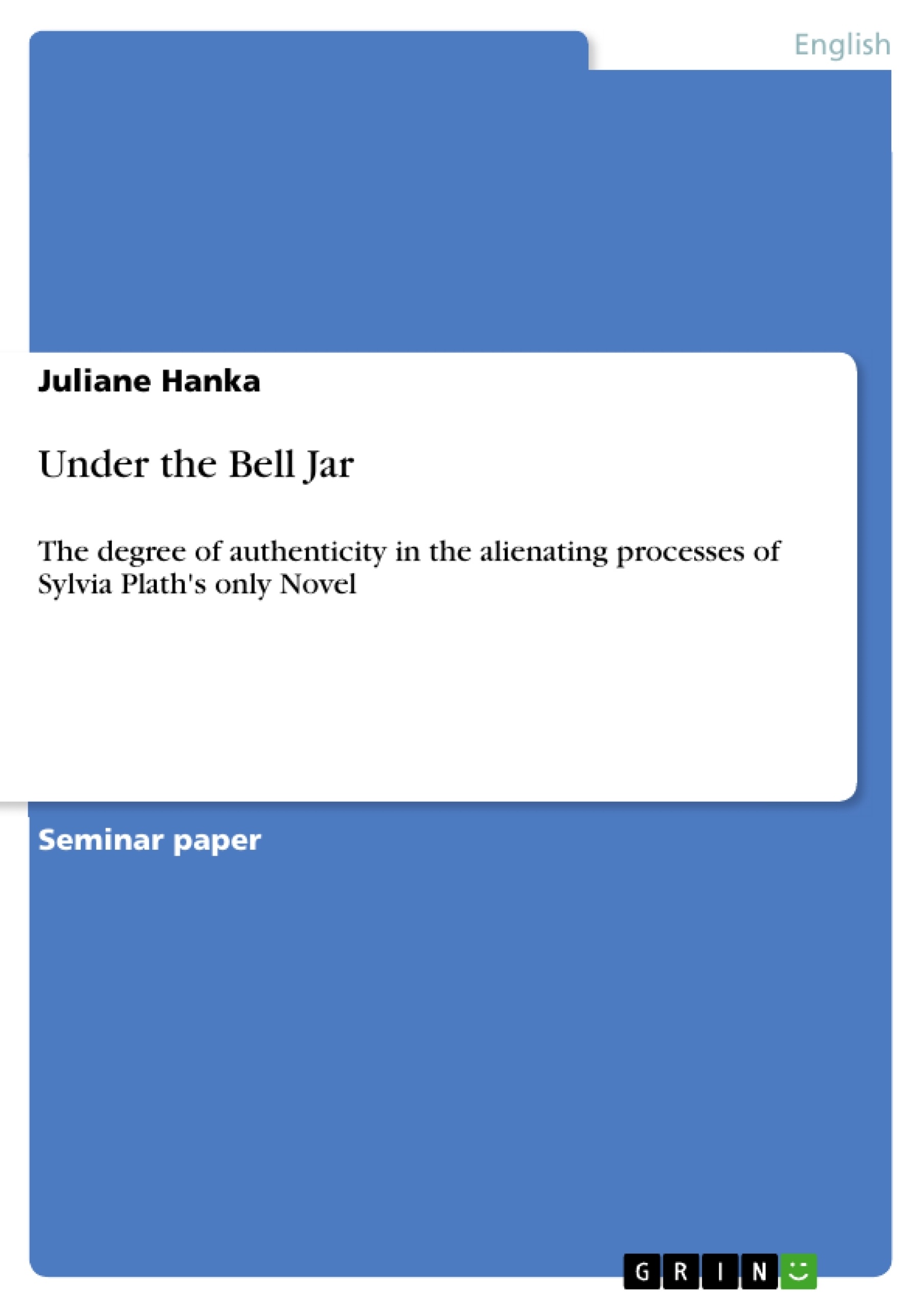1 Introduction
Sylvia Plath ended her Life by gassing herself in a stove on February 11th in 1963. This is not the most important fact about the poet and yet the best known detail of her life. Since her death, Plath’s work and her life have been irrevocably interblended. Thus, she is either interpreted as a courageous but suppressed female writer or as a dark and mentally disordered summoner of death. In either case she had been mystified as a kind of tragic hero and some critics continue with this kind of blind “Plathophilia” (Bachner 2008) until today. Although her artistic work is mainly composed of poems, her only novel will be the object for the following interpretation of the protagonist’s alienation in comparison to respective events in the author’s life.
Being so closely connected it is impossible to reflect on the novel without factoring her life into the described events of alienation in The Bell Jar. Thus, after introducing the influencing social circumstances of her time, the paper concentrates on Sylvia Plath’s degree of authenticity in her writing. On the basis of these findings, two different stages of the protagonist’s alienation are to be developed and afterwards her ambivalent relation towards the opposite sex is being discussed as a major consequence to her schizoid attitudes towards her desired social status. Finally, the analysis deals with Plath’s strong symbolism, in which the mirror serves as frequent metaphoric means to illustrate estrangement not only from the outside world, but also from her inner self. Another one, the fig-tree, stands for the inability to decide for a certain way of life. Both are crucial problems of the protagonist Esther Greenwood and it is to examine, in how far they reflect on Sylvia Plath’s personal experience. This paper discusses Plath’s alienating processes from a rather feminine perspective as the 1950s common American values exerted huge pressure on every member of society, but mostly on women.
Inhaltsverzeichnis (Table of Contents)
- Introduction
- The 1950s in America
- Life in the 1950s
- Women in the 1950s
- Sylvia Plath – Integration or Independence?
- The Bell Jar – Fact or Fiction?
- A Short Synopsis of The Bell Jar
- Esther Greenwood versus Sylvia Plath
- Bits of Inner and Outer Reality
- Alienation
- Alienation from Society
- Psychological Alienation
- Relation to Men
- Symbols of Alienation
- The Fig-Tree
- The Mirror – A Double?
- Conclusion
Zielsetzung und Themenschwerpunkte (Objectives and Key Themes)
This paper aims to analyze the degree of authenticity in Sylvia Plath’s only novel, "The Bell Jar," in relation to the author's life and the social context of the 1950s. The paper explores the protagonist's alienation, considering its social, psychological, and relational aspects. The key themes explored in the paper include:- The impact of 1950s American society on women and their societal expectations.
- The protagonist's struggle with integration versus independence in a restrictive social environment.
- The relationship between the author's life and the fictional world of "The Bell Jar," exploring the boundaries between fact and fiction.
- The various forms of alienation experienced by the protagonist, including social, psychological, and relational alienation.
- The use of symbolism, specifically the fig-tree and the mirror, to represent the protagonist's internal struggles and estrangement from the world.
Zusammenfassung der Kapitel (Chapter Summaries)
The introduction establishes the context of Sylvia Plath’s life and the significance of her novel, “The Bell Jar”, as a window into the protagonist’s experiences of alienation. The paper emphasizes the importance of understanding Plath’s life in relation to her work. Chapter two sets the scene by examining the social climate of 1950s America, focusing on the economic prosperity, societal expectations, and gender roles that shaped the time. The chapter highlights the dominant theme of social conformity and its impact on women, particularly in terms of their supposed roles in society. Chapter three explores the concept of alienation within the context of Sylvia Plath’s life and her writing, emphasizing the tension between societal integration and personal independence. This chapter delves into the protagonist’s individual journey and challenges within the rigid social framework of the 1950s. Chapter four focuses on the novel "The Bell Jar," examining its relationship to the author's life and the degree to which it reflects real events. The chapter delves into the protagonist’s character, her internal struggles, and the blurred lines between fact and fiction in the novel. Chapter five dives deeper into the concept of alienation as experienced by the protagonist, exploring its social, psychological, and relational manifestations. The chapter highlights the protagonist's isolation and the consequences of societal pressures.Schlüsselwörter (Keywords)
The primary focus of this paper is on Sylvia Plath, "The Bell Jar," alienation, 1950s American society, gender roles, social conformity, authenticity, and symbolism. The paper explores the themes of integration versus independence, fact versus fiction, and the different forms of alienation. The analysis of the novel, "The Bell Jar," delves into the protagonist’s internal struggles and the impact of societal pressures.- Quote paper
- Juliane Hanka (Author), 2008, Under the Bell Jar, Munich, GRIN Verlag, https://www.hausarbeiten.de/document/112217


